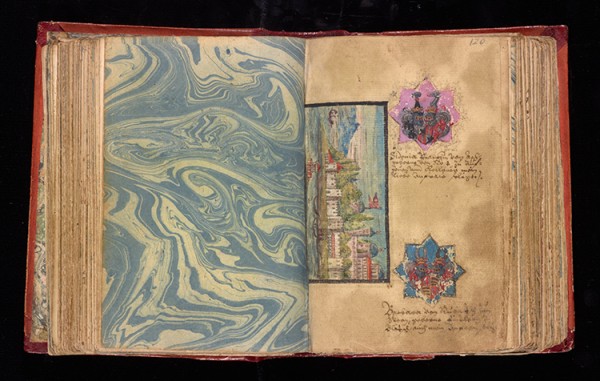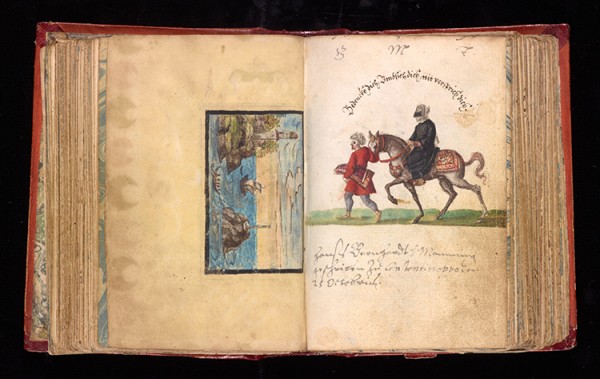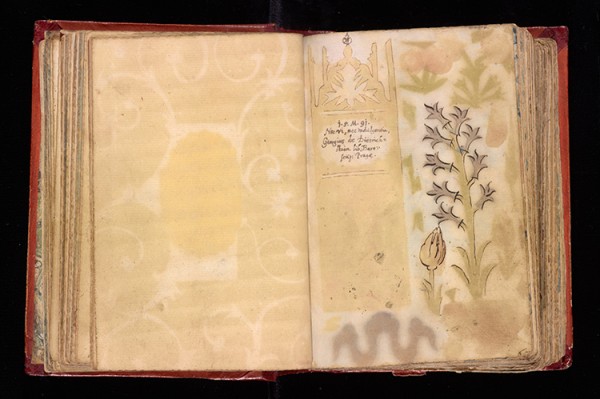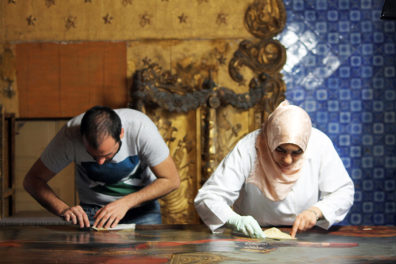A rare and fascinating book that chronicles political, cultural, and personal encounters along the edge of the Christian and Muslim worlds has just joined the collection of the Getty Research Institute

Leaf 119 verso and 120 recto from Johann Joachim Prack von Asch’s liber amicorum (book of friends), 1587–1612. The Getty Research Institute, 2013.M.24
This liber amicorum (“book of friends”) was compiled by Johann Joachim Prack von Asch, a military attaché of the Holy Roman Emperor Rudolph II’s embassy to the Ottoman court at Constantinople. It contains entries spanning 1587 to 1612. Most were penned in Istanbul and neighboring Bohemian regions traversed by Prack during his diplomatic travels. Explore the fully digitized book here.
The 25-year timespan of the entries parallels the so-called Long War, or Thirteen Years’ War, fought from 1593 to 1606 between the Holy Roman Empire and Ottoman Islam. It also contains traces of the political intrigues that led up to that war—and followed it.
As a “book of friends,” the volume is an elite scrapbook filled with entries by Prack’s friends and contacts. These additions include allegorical scenes, emblems, coats of arms, poetry and mottoes written with calligraphic flourish, and even figural scenes in watercolor based on Ottoman miniature paintings, which were ubiquitous in the bazaars of Istanbul in the late 16th and early 17th centuries.
The page shown below, for example, bears the arms and inscription of Philip Riedesel von Camberg, general of the Danube Fleet in the Turkish War.

Leaf 257 verso and 258 recto from Johann Joachim Prack von Asch’s liber amicorum (book of friends), 1587–1612. The Getty Research Institute, 2013.M.24
Other contributors to the volume’s pages include Dr. Barthlmä Pezzen, Emperor Rudolph II’s chief military representative to the Ottoman court, and Friedrich von Kreckwitz, a diplomatic attaché to the Ottoman court. In 1593, two years after he signed Prack’s book, von Kreckwitz was arrested by Ottoman authorities and forced to fight for them against Imperial Catholic forces.
Other notable entries come from members of the Geizkofler family from Gailenbach, perhaps most notably, Zacharias Geizkofler—minister of treasury and finance to the Holy Roman Emperor. His nephew, Hans, signed Prack’s book on August 25, 1594, at Raab, Hungary. Three days later, he was killed by Ottoman forces when they seized the fortress at Raab. A note indicating this on leaf 166 (shown below at left) is inscribed under his autograph in the hand of his father, Abraham Geizkofler, whose own inscription appears on the very same page.

Leaf 166 verso Leaf 167 recto from Johann Joachim Prack von Asch’s liber amicorum (book of friends), 1587–1612. The Getty Research Institute, 2013.M.24
Also of note in this “book of friends” is the array of Ottoman decorative papers bound into the pages, which present a far wider range of Islamic papermaking art than can be found in any other European liber amicorum from the period. Not only does the manuscript record the hybrid visual culture in Istanbul under the Ottoman Empire, but also the identities of those who inscribed Prack’s album with dates and dedicatory poems.
Interesting historical note: The papers in the album were almost certainly purchased from the Covered Bazaar in Istanbul, which was the original site of the ancient Chartoprateia, or paper market, of Constantinople.
As a whole, the album provides unique testimony to the vast social network at a time when Europe made furtively shifting alliances and diplomatic intrigues with the powers of Ottoman Islam.

Leaf 121 verso and 122 recto from Johann Joachim Prack von Asch’s liber amicorum (book of friends), 1587–1612. The Getty Research Institute, 2013.M.24
This liber amicorum will be on view at ESMoA, the art laboratory in El Segundo, starting June 8 alongside another rare book from a similar genre, the 17th-century “book of friends” (liber amicorum) of German merchant Johann Heinrich Gruber, which last year inspired a 21st-century artistic reinterpretation, LA Liber Amicorum, nicknamed the Getty Graffiti Black Book. The exhibition, SCRATCH, presents the Black Book, the two historical examples, and a full-gallery “open black book” installation curated by local graffiti artists Axis, Cre8, Defer, Eye One, Fishe, and Miner, who worked with us at the Getty in creating LA Liber Amicorum.

Leaf 57 verso and 58 recto from Johann Joachim Prack von Asch’s liber amicorum (book of friends), 1587–1612. The Getty Research Institute, 2013.M.24




Comments on this post are now closed.